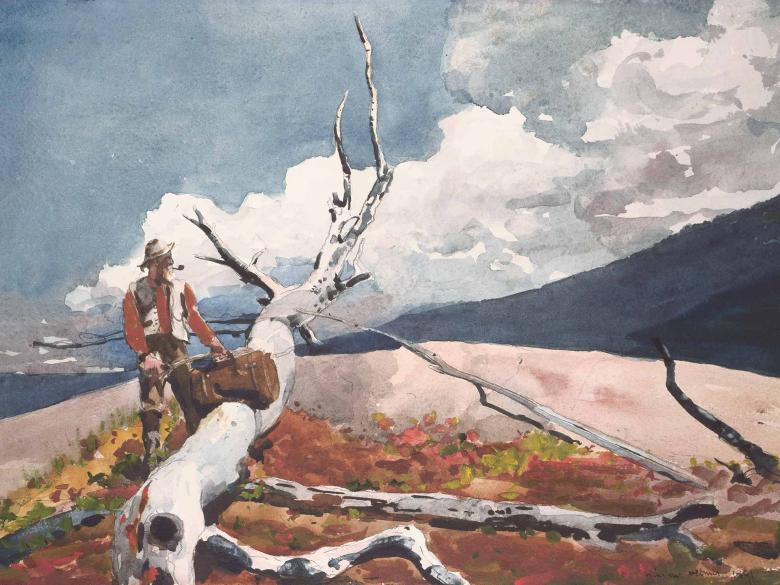As a lifelong New Englander, Winslow Homer seems to have been born with an appreciation for the sea. His paintings deftly capture it through all seasons and situations: waves surging during a harrowing storm, the sun setting over calmer waters, and the hardships and pleasures of daily life on the coast.
Beloved for his depictions of coastal scenes at home and abroad, Homer traveled widely, painting the beauty of the wilderness in its many forms. Watercolor became his preferred medium while traveling, as it was portable and dried quickly. When he wasn’t at his studio—first in New York City and later in Maine—Homer was often producing watercolors somewhere around the globe; England, Cuba, Florida, and many other diverse locales attracted his eye. No matter where he painted, he experimented with composition using his hallmark vivid palette and fluid brushstrokes.
Today, the MFA houses the largest collection of Homer’s watercolors in the world, and the exhibition “Of Light and Air: Winslow Homer in Watercolor” brings nearly 50 of them on view for the first time in decades. To add to your appreciation of the show, find out what drew Homer to places from the lush back woods of the Adirondacks to the cerulean waters of the Bahamas.
Maine
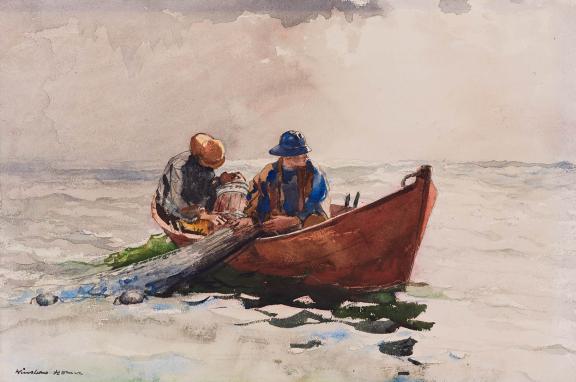
Out of all the places Homer whiled away his days painting, Maine was perhaps closest to his heart. In the mid-1880s, his family built a small compound in Scarborough, Maine, just south of Portland—a place they’d come to love after summering there. Homer’s brother Charles converted the home’s nearby carriage house into a studio and living space for Winslow, who spent more than 25 years working there between his extended trips to other places around the world.
The property, situated on a peninsula called Prouts Neck, offers sprawling views of Saco Bay, overlooking its undulating sapphire waters. It’s where Homer painted some of his most well-known works, including Driftwood (1909), which depicts a tumultuous sea scene of the rocky coastline just beyond his studio. Though he created many oil paintings of Maine that juxtapose jagged rocks with blue-green swells of the ocean, Homer also spent nearly a decade working on his watercolors here. In these, he explored the daily lives of fishermen on Prouts Neck, such as in The Dory (1887), which shows two men pulling a net into their canoe, and continued to render the coast’s choppy waters, like in Breaking Wave (1887).
Gloucester
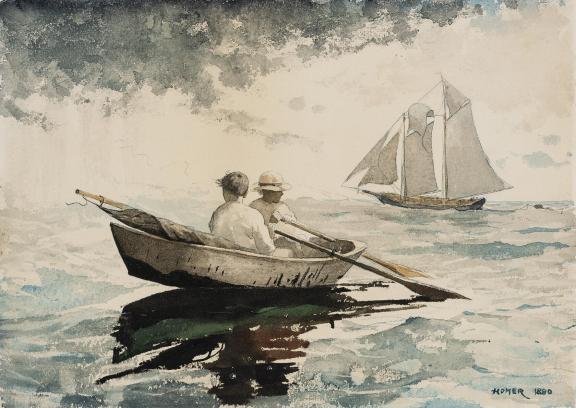
The New England coast was a constant source of inspiration for Homer, and Gloucester, Massachusetts, roughly 30 miles from Boston, played a starring role in many of his works. During his 1880 visit there, he painted roughly 100 watercolors, averaging more than one a day. It was more than he produced at any other time, according to American Passage, a 2022 biography of Homer by William R. Cross. Here, the artist turned his eye on schooners, sunsets, and local life. J. Eastman Chase, an art dealer and one of Homer’s friends, viewed the painter’s time in Gloucester as one where he honed his chief interests: “… thereafter, for most of his life, it was the sea and the humble folk who live on and get their living out of it that chiefly interested him.”
Gloucester’s children and young boys, in particular, are a motif; they’re often pictured near the harbor or playing on boats. Some of the artist’s favorite themes were childhood leisure and boyhood—a sharp contrast to the rugged challenges of adulthood at that time. As a backdrop to many of these childhood scenes in Gloucester, Homer painted gentle sweeps of color in the skies and sea, underscoring his appreciation for the soothing shades of the waterfront.
The Adirondacks
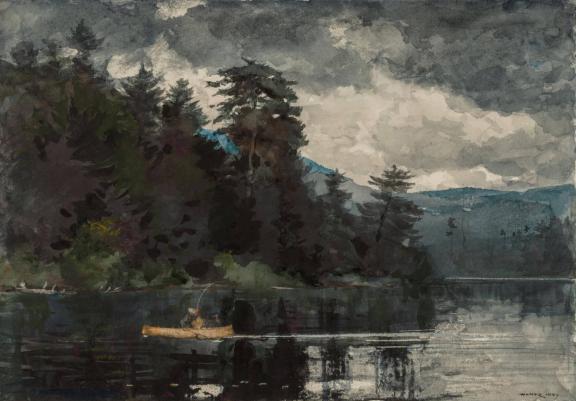
In a departure from his vivid seaside scenes, Homer took to another kind of aquatic landscape in the Adirondacks region of upstate New York: rivers and lakes. He captured fishing, hunting, and logging there, rendering both the rugged and peaceful natures of the mountainous landscape. Homer traveled to the Adirondacks more than 20 times over 40 years, resulting in more than 100 works. Some scholars suspect no other place he traveled to held his attention for so long of a time.
While Homer relished painting the area’s natural scenes, he was also an avid outdoorsman. He enjoyed hunting and fishing with his brother Charles, and they became founding members of the North Woods Club, a private game and fishing reserve they visited annually. Naturally, Homer began painting men fishing—as well as detailed works of fish—and stirring hunting scenes. The Adirondack Guide (1894) shows a naturalist and guide named Rufus Wallace returning from a duck-hunting trip in his canoe, while Trout Breaking (1889) highlights Homer’s fascination with the moment a fish leaps out of the water. In this watercolor, he pays close attention to the trout’s markings and coloring, and also inserts two butterflies gently floating nearby.
England
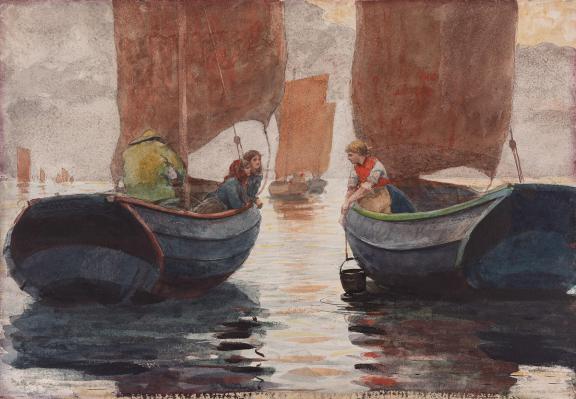
For more than a year and a half—from the spring of 1881 to the fall of 1882—Homer traveled across England. He began his journey in London, eager to see the works of English artist J. M. W. Turner in person. Ahead of his trip, Homer had been carefully studying watercolors and color theory, so it only made sense to seek out works by one of the world’s most famous watercolor painters at the time. The visit to London marked a turning point in Homer’s career—one that helped him fully explore his passion for watercolors.
Afterward, Homer settled in the fishing village of Cullercoats, on the country’s North Sea coast. His paintings from there focus on the women of the village “and their spirit of resilience in the face of daunting economic and climatic conditions,” writes Cross. In Tynemouth Sands (1882–83), these women are shown carrying large baskets and raw fish, their reflections captured in a shimmering tide pool as the sea dissolves into mist behind them. In An Afterglow (1883), a group of women converse between boats as the sun casts an ethereal glow on the harbor. Homer’s time in England further solidified his fascination with human relationships to the natural world.
The Bahamas
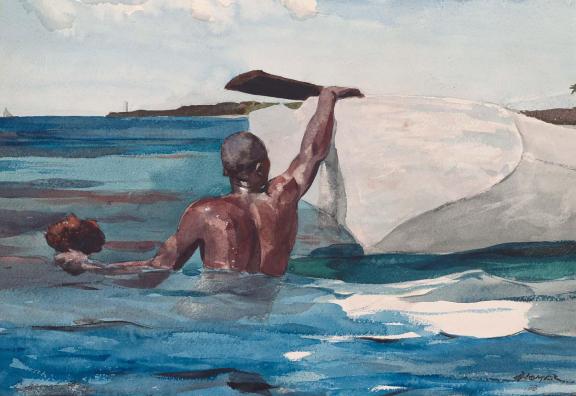
Homer spent two months producing more than 30 watercolors of scenes in the Bahamas: namely of coral and sponge fishing, fruit trees, island architecture, and day-to-day life. He’d originally traveled to Nassau in 1884 on assignment for The Century Magazine—his goal was to illustrate an article about the city’s reputation as a respite for ill people suffering through cold winters in the Northeastern United States. He was quickly charmed by the place and stayed through the following year with his father.
After that first extended visit, Homer returned to the Bahamas in 1898. “I think the Bahamas the best place I have ever found,” he wrote. On the second trip, he grew interested in the region’s storms and hurricanes; it’s where he produced his epic work, The Gulf Stream (1889, reworked by 1906), now in the collection of New York’s Metropolitan Museum of Art, which shows a Black man balancing precariously on a small wave-jostled boat as sharks surround it. A less precarious scene, The Sponge Diver (1898–99) explores how a Bahamian man excavates one of the country’s main exports in the region’s translucent waters. According to the Grand Bahamian Museum, about one-third of the total male Bahamian workforce worked in coral fishing during the industry’s peak in 1900.
Cuba

In February 1885, on his first trip to the Bahamas, Homer left Nassau to spend a month in Cuba. There he deviated from his iconic coastal works, painting the architecture of Santiago de Cuba, the island’s Spanish colonial influences, and other local scenes in more muted colors. His watercolor Street Corner, Santiago de Cuba (1885), shows two people walking up a shadowy hill toward a building bathed in sunlight.
Some scholars view the pivot in subject matter and palette in Homer’s Cuban works as a result of political tensions between the United States and Cuba at the time. Following the 1898 Spanish-Cuban-American War, Homer painted Searchlight on Harbor Entrance, Santiago de Cuba (1902), now at the Met. It’s thought that he was commenting on power dynamics among the nations, comparing the aging canons on the coast to the US Navy’s powerful searchlights.
Florida

Homer began to explore Florida on another trip in search of warmer climes. Following a brief stint in Tampa in the mid-1880s, where he captured the state’s spiky palm trees in Thornhill Bar (1886), he sailed to Key West, paying even closer attention to the landscape. Here, Homer depicted tropical characteristics he hadn’t found in Cuba or the Bahamas: Key West’s sense of isolation and its exposure to strong winds.
On the mainland, he portrayed the lush foliage and fishing scenes of places like Lake Monroe, just north of Orlando. “This is the most beautiful place in Florida,” Homer once wrote to his patron Thomas Benedict Clarke. “I commence work & play tomorrow—& expect to show you something when I return.” During a later trip to Homosassa, a town on the Gulf of Mexico, he completed Palm Trees, Florida (1904), paying close attention to the variety of trunk shapes and foliage within the cluster of trees.
Homer’s command of watercolor as a medium was sharpened with each additional trip he embarked on. As one of the world’s most famous marine painters, he delighted in portraying the swells of the ocean, whether from his home in Maine or on the beach in the Caribbean. Water and coastal life remain a throughline in his works—fitting subjects for a master of painting with water.
